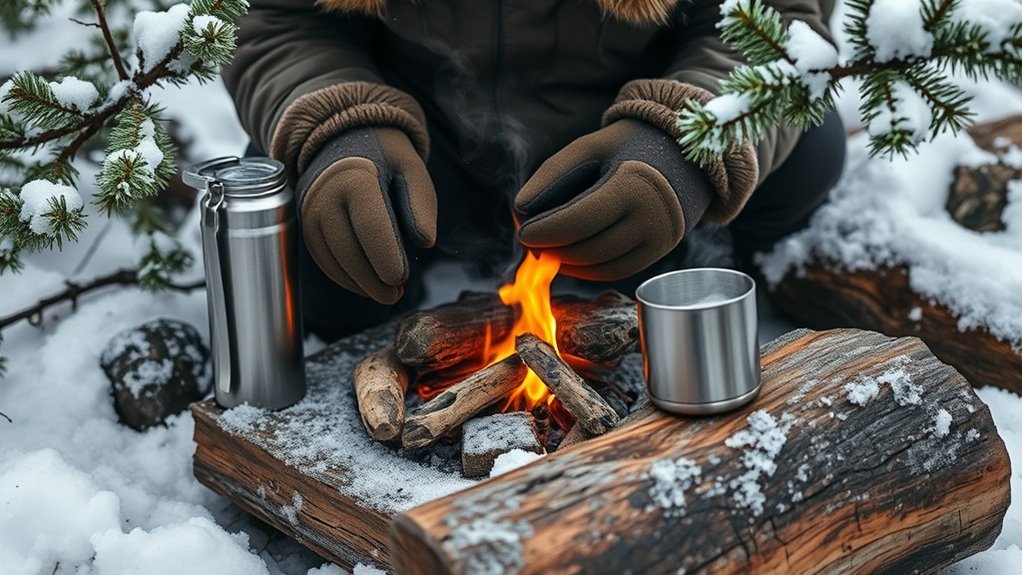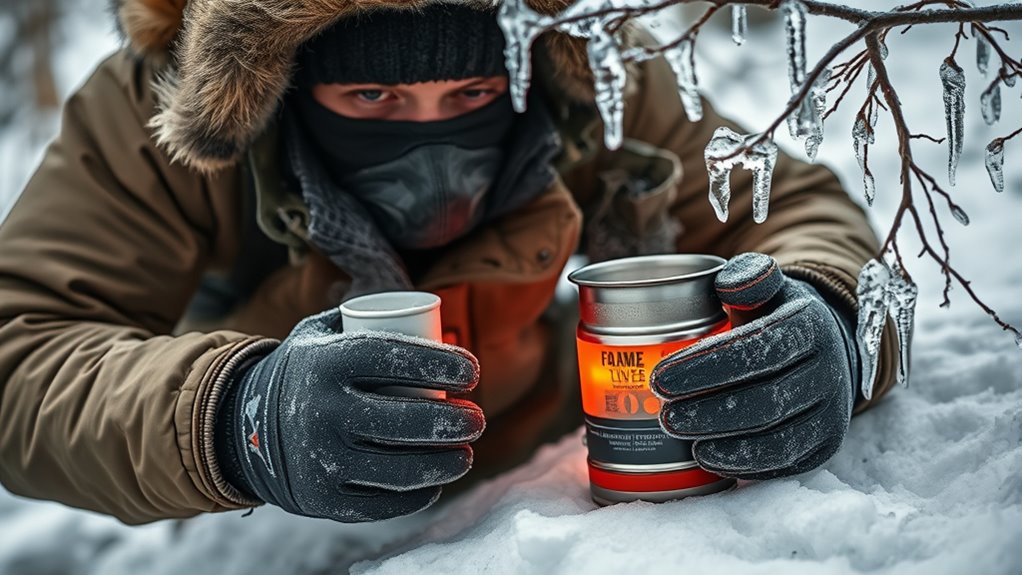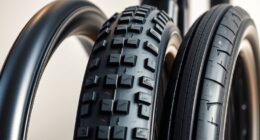To adapt to cold weather and stay fueled, you should layer moisture-wicking, insulating, and windproof clothing that fits snugly but comfortably. Keep hydrated with warm beverages and sip fluids regularly, as dehydration can hide in cold. Increase your carbohydrate intake to match higher energy needs, and carry high-calorie, cold-resistant snacks. Proper clothing and nutrition boost warmth and performance, helping you stay safe. Continue exploring for detailed tips to optimize your cold-weather outdoor experiences.
Key Takeaways
- Layer moisture-wicking base layers with insulating mid-layers and windproof outer shells to maintain warmth during outdoor activities.
- Consume regular, carbohydrate-rich snacks or gels to meet increased energy demands in cold conditions.
- Stay hydrated with warm fluids like herbal tea or electrolyte drinks to support hydration and electrolyte balance.
- Adjust clothing and fueling strategies based on body signals to prevent hypothermia and dehydration.
- Keep fuel and hydration sources protected from freezing to ensure accessibility and effectiveness during activity.

As temperatures drop, adapting your fueling strategies becomes vital to maintain energy and performance. Cold weather can drain your energy faster, so you need to be intentional about how you prepare your body for the chill. Wearing the right thermal clothing is an essential step. Layering with moisture-wicking base layers, insulating mid-layers, and a windproof outer shell helps keep your core warm and prevents heat loss. When your body stays warm, your muscles stay looser, reducing injury risk and improving efficiency during activity. Make sure your thermal clothing fits well but isn’t too tight, as restricted movement can hinder performance and circulation.
Hydration strategies shift in colder weather because you might not feel as thirsty, even though you’re still losing fluids through respiration and sweat. Dehydration can impair your performance and recovery, so don’t neglect hydration. Aim to drink regularly, even if you’re not thirsty, and include warm fluids like herbal tea or warm water with electrolytes to help maintain your electrolyte balance and keep your core temperature stable. Carry a hydration pack or water bottle that’s easily accessible during your activity, and consider pre-hydrating before starting your workout. It’s also wise to include electrolytes in your drinks to replace the minerals lost through sweat, which can be more insidious in cold conditions since you might not notice the signs of dehydration as readily.
In addition to thermal clothing and hydration, plan your fueling to prevent energy dips. Cold weather increases energy expenditure, so consuming carbohydrate-rich snacks or gels during your activity can sustain your blood sugar levels. Pack easily portable, high-calorie foods that won’t freeze easily—think energy bars or gels that are designed for cold conditions. Eating small amounts frequently helps maintain energy without overwhelming your stomach or causing discomfort, which can be more common in chilly weather. Keep your fuel accessible and protected from the cold, as frozen or hard-to-open packaging can cause delays or frustration. Incorporating proper clothing layers into your preparation not only keeps you warm but also supports your overall performance and safety.
Finally, pay attention to your body’s signals. Cold weather can mask fatigue or dehydration symptoms, so stay vigilant. Adjust your clothing, hydration, and fueling plan as needed based on how you feel. Proper preparation with thermal clothing and hydration strategies guarantees you stay warm, energized, and safe, allowing you to enjoy your outdoor adventures despite the chill.
Frequently Asked Questions
How Does Cold Weather Affect Athletic Performance?
Cold weather can decrease your athletic performance by impairing cold muscle function, making movements less efficient and increasing injury risk. However, your metabolic rate increases as your body works harder to stay warm, boosting energy expenditure. To perform well, you need proper warm-ups, layered clothing, and adequate fueling to counteract these effects and maintain ideal muscle function and endurance in cold conditions.
What Are the Best Clothing Layers for Cold Weather Training?
You should layer with thermal insulation and moisture-wicking fabrics for cold weather training. Start with a snug, moisture-wicking base layer to keep sweat away from your skin. Add an insulating middle layer for warmth, like fleece or wool. Finish with a windproof, waterproof outer layer to shield you from the elements. This juxtaposition of warmth and breathability keeps you comfortable and dry, maximizing your performance even in freezing conditions.
How Can I Prevent Frostbite During Outdoor Activities?
To prevent frostbite during outdoor activities, you should prioritize frostbite prevention and follow outdoor safety tips. Keep your skin covered with insulated, moisture-wicking clothing, and wear gloves, hats, and face protection. Take regular breaks to warm up, stay dry, and avoid prolonged exposure to cold temperatures. Monitor your skin for signs of numbness or discoloration, and seek warmth immediately if you notice any symptoms.
What Are Signs of Hypothermia to Watch For?
You should watch for signs of hypothermia like shivering, confusion, and slurred speech. As cold weather injuries worsen, you might notice numbness, clumsiness, or exhaustion. If you see someone displaying these signs, get them to a warm place quickly, remove wet clothing, and offer warm drinks. Recognizing early signs of hypothermia is vital to prevent serious health issues during cold weather activities.
How Does Cold Weather Impact Hydration Needs?
Cold weather increases your hydration needs because you lose fluids through respiration and sweating, even if you don’t feel thirsty. To stay properly hydrated, you should follow hydration strategies that include drinking fluids regularly, regardless of your activity level or temperature. Make sure your fluid intake includes warm beverages and water-rich foods, which help prevent dehydration and keep your body functioning at its best in cold conditions.
Conclusion
As you prepare for cold weather, remember that proper fueling can boost your performance and keep you warm. Did you know that athletes who optimize their carbohydrate intake in cold conditions see up to a 20% improvement in endurance? Staying well-fueled and adapting your strategies guarantees you stay energized and safe. So, don’t overlook your nutrition—embrace these tips, stay active, and enjoy your adventures even in the chilliest weather!









